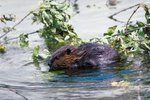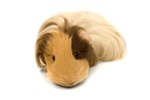
The raccoon (Procyon lotor) is a meek creature that is prevalent all over both North and Central Americas -- from Canada and the United States to El Salvador and Belize. These furry and rotund mammals live in all sorts of different environments -- think quiet woods, prairies, bustling urban parks, residential areas and marshes. Although raccoons usually aren't interested in starting problems with people, they do defend themselves when they feel the need.
About Raccoons
Raccoons are not particularly aggressive creatures. They usually possess tame temperaments and are typically seen foraging for sustenance during the nighttime -- oftentimes amidst heaps of trash. They just aren't picky diners. Although raccoons do not generally go out of their way to be aggressive or defensive around human beings, attacks are indeed a possibility, albeit rare. These sturdy animals tend to weigh anywhere between 4 and 23 pounds. Their bodies are usually between 23.75 and 37.5 inches long.
Vocalization
When raccoons are in frightening situations, they often respond by vocalizing defensively. They produce a lot of defensive sounds, including barking, hissing, screaming, shrieking and growling. Their growling has a guttural quality to it. When they make these sounds, their teeth are usually prominently visible, as well -- another "warning" defensive display.
Body Language
If a raccoon feels the need to defend himself by physically attacking, he'll probably provide several body language hints before he goes into full fight mode. Some defensive clues to look out for are the fur sticking up straight into the air, thrashing of the tail, elevated tail, rounded back and pressed down ears. When a raccoon is scared or getting ready to protect himself, you may observe all of those defensive bodily responses. They also often leap up and down repeatedly in these types of situations. When raccoons stick their fur up, it is their way of trying to look bigger, and therefore more intimidating.
Attack Mode
If a raccoon feels like he has no way to exit a situation, he may resort to attacking a human being or domestic animal such as a cat or dog. Raccoon bites, like all animal bites, can be extremely hazardous, and can sometimes even bring upon fatal diseases such as rabies. In the event of any raccoon attack, urgent and immediate medical assistance is of the essence -- no time to wait around.
References
- New York State Department of Environmental Conservation: Raccoon
- Wildlife Information Network: Common Raccoon
- National Geographic: Raccoon
- The IUCN Red List of Threatened Species: Procyon Lotor
- NatureWorks: Raccoon
- Washington Department of Fish & Wildlife: Raccoons
- Wisconsin Department of Natural Resources: Raccoon
- Fairfax County Public Schools: Raccoon
- City of San Antonio: Raccoon Facts
Photo Credits
-
Hemera Technologies/Photos.com/Getty Images




